Fall Fashion Trends in Wearable Technology
The first “wearable” electronic technology to emerge on the market was a digital watch, the Hamilton Pulsar, which was released in 1972 at the price of $2,100 and featured an LED display behind a ruby crystal.1 Since then technologists, fashion designers, sports equipment companies, the healthcare industry, and AR/VR developers, among others, have been fascinated with ways to weave technology into our clothing, accessories, and daily lives.
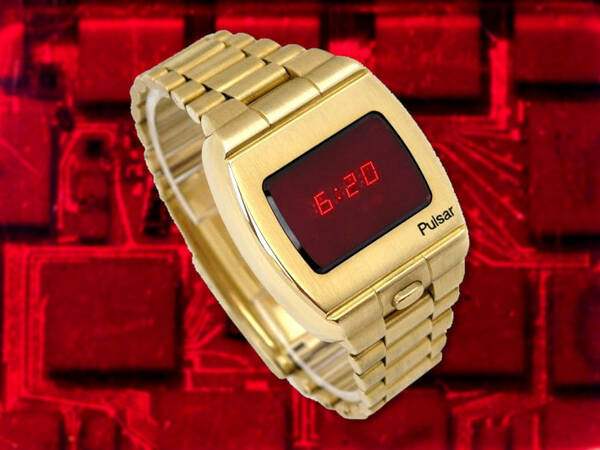
The Hamilton Pulsar P1 Limited Edition digital watch, encased in 14-carat gold. (Photo: diginut).
By 2014, activity trackers started catching on, and the Nike+ Fitbit and Google Glass had been released, earning it the nickname: “The Year of Wearable Technology”.2 The blockbuster Apple Watch first came out in 2015, helping the previously niche product category break out into the mass market.3
Today, wearable device sales are expected to reach 225 million units globally in 2019, with smart watches accounting for 74 million (about 33%) of those. Smart ear pieces (“hearables”) are expected to become the top segment by 2022, as total wearable unit sales grow to 453.19 million worldwide that year.4
Staking Out the Body’s Real Estate
The popularity of fitness trackers and smart watches has turned the wrist into the number one location for wearable tech to date. Smart glasses and visors are gaining popularity as well, which, along with smart headbands and ear-worn devices, have made the head another popular technology site on the body.
But other parts of the human geography are also attracting attention as places where displays and technology can be integrated. For example:
- A biosensor patch worn on the chest continuously monitors heart rate, respiration, and temperature for people with medical conditions
- A smart sleeve, smart shirts, and even a smart sports bra monitor a range of vital signs and activity metrics for fitness enthusiasts
- Hospitals use a smart sock to monitor the vital signs of newborn babies in the nursery, while runners use connected socks to monitor pace and distance.
- Smart bathing suits monitor UV exposure and warn you when it’s time to get out of the sun.
- Smart rings are on the rise with functions ranging from simple electronic “mood rings” to fitness tracking, gesture-response, electronic payment, and miniature notification screens.
- Bracelets, pendants, and sticker sensors are being tested as potential assault protection and prevention devices for woman, with built-in alarm and notification functions.
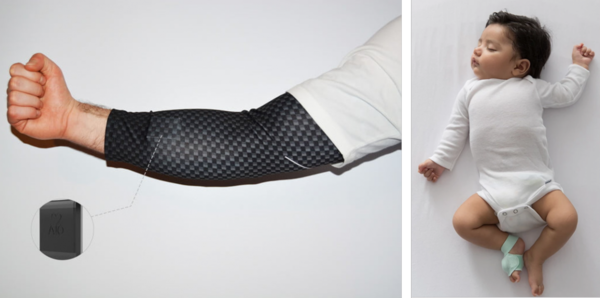
The AIO Sleeve (left) measures heart rate variability and other biometric data; the Owlet sock (right) monitors a baby’s heart rate, oxygen rate, and sleep. (Images: Digital Trends (left) and Owlet.com).
Functional Applications
The wearable tech landscape can be grouped into three different functional categories: sensor/monitoring, information display, and visible light functionality. The first category is focused on sensing and monitoring the body’s activity—from fitness and sleep trackers to medical monitoring devices. These products typically integrate with an app on your phone or some other device that captures the information from wearable sensors. New types of “smart textiles” are in development/prototype that incorporate sensors within the fabric of clothing. Many wearable devices enable the user to view and interact with their data through a connected display, for example via a smart phone app.
Another integration of technology and clothing has been decorative application of LED strips and lighted panels. In 2015, Dutch researchers created stretchable and conformable thin-film-transistor driven LEDs laminated onto textiles.5 In 2015 and 2016, applications of LED strips, bioluminescence, and other lighted effects were all the rage on the runways of New York Fashion Week.
You can now order a light-up hoodie to wear to your next rave. LEDs are also being used in clothing for safety purposes, for example, a vest that provides visibility for pedestrians, joggers, and cyclists out after dark.
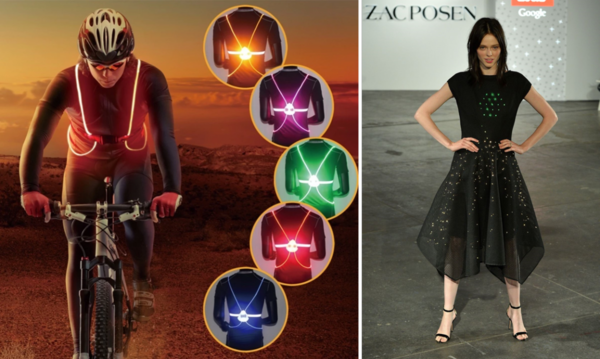
Seasonmore LED safety vest (left) and an LED-enhanced dress by fashion designer Zac Posen (right). (Image Sources: Seasonmore.com (left) and Zac Posen dress from Adweek).
The third category of wearbles include smart watches and smart headgear that incorporate display screens to provide the user with information, such as time, weather, activity data, or communication alerts. But what about integrating display screens into actual clothing? That’s coming too. South Korean researchers have found a way to protect electronic display elements from moisture, making it possible to create wearable, washable fabric displays.6
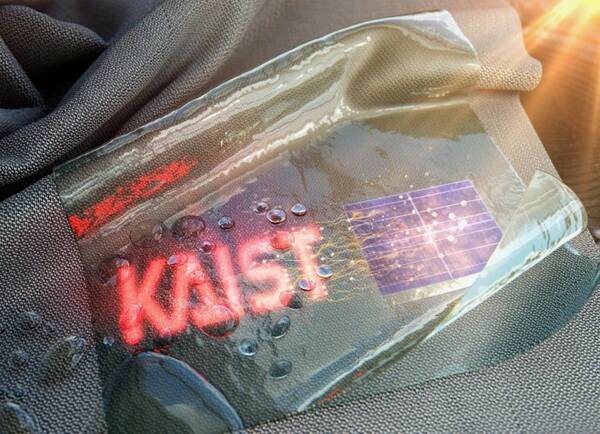
Textile-based wearable display module technology that’s washable and doesn’t require an external power source. (Image: Asian Scientist)
Wearable Display Screen Technology
For the moment, however, wrist devices and headsets still dominate the wearables category. Smart watch and wrist-worn devices are typically just 1/2” –to 2” per side. For smart watches, a backlit TFT LCD or OLED display screen technology is generally used, or in some cases an electronic paper display for reflectivity and to reduce power usage.
The flexibility of active matrix OLED (AMOLED) displays lends themselves them to more creative wearable designs in future.7 The current advantages of AMOLED vs. PMOLED technology for wearable applications have been summarized by US Micro Products:
|
AMOLED Advantages
|
PMOLED Advantages
|
Comparison of AMOLED and PMOLED screens for wearable applications. Source: US Micro Products
At the same time, developers are reportedly working on microLED versions of smart watches that could be released to market in 2020.8 MicroLEDs potentially can be thinner and more brilliant, and offer faster response time and reduced burn-in compared to OLED panels.
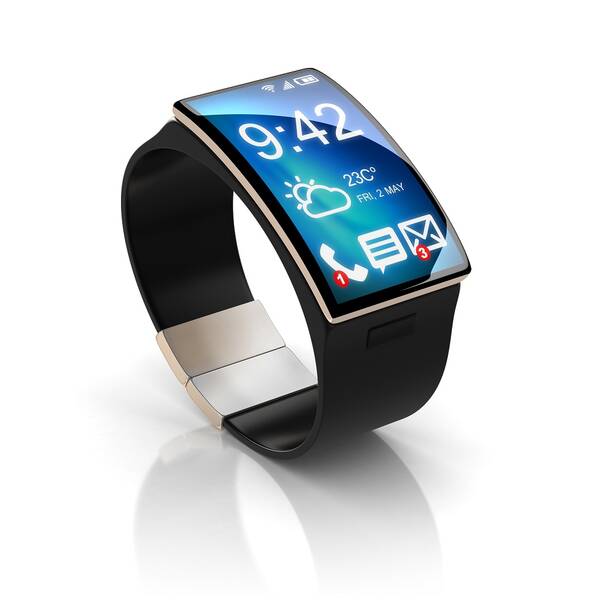
A smart watch with OLED display screen.
Ensuring Quality of Wearable Displays
Whether LCD, OLED, microLED, or other display technology, smart watches and wearable display devices demand rigorous quality inspection to ensure visibility and clarity through day-to-day use in a broad range of viewing environments—from darkness to full sunlight. To inspect and qualify these displays, Radiant provides high-resolution imaging systems that match the discernment of human vision.
Our ProMetric® Imaging Photometers and Colorimeters offer high-resolution, low noise, precision imaging down to the pixel and sub-pixel level. Used with TrueTest™ software, our systems help to ensure that LCD, OLED, and microLED displays look impeccable and perform well perfectly right out of the box. Stay tuned for a future post where we’ll take a more in-depth look at smart glasses, visors, and other head-mounted wearable technology products and how Radiant ensures the quality of these devices.
CITATIONS
- Edwards, B., “The Digital Watch: A Brief History”, PC Magazine, October 17, 2018
- Spence, E. “2014 Will Be The Year of Wearable Technology”, Forbes, November 2, 2013.
- Thompson, J., “A Concise History of the Smartwatch”, Bloomberg, January 8, 2018.
- “Gartner Says Worldwide Wearable Device Sales to Grow 26% in 2019”, Press Release on Gartner.com, November 29, 2018
- “Turning clothing into information displays”, The Innovation Society, July 9, 2015.
- “Clothes As Display Screens? Scientists Are Working On It”, Asian Scientist, April 3, 2019
- Feifei, F., “OLED maker Visionox to expand presence in smartphones, wearable devices”, China Daily, July 17, 2019.
- Kuo, R. and Shen, S., “Micro LED-based smartwatches to hit market in 2020, say sources”, DigiTimes, June 24, 2019.
Join Mailing List
Stay up to date on our latest products, blog content, and events.
Join our Mailing List
